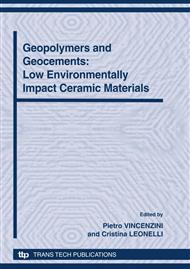[1]
M. Weil, A. Buchwald, K. Dombrowski, W.R. Poganietz: Managing emerging technologies – Sustainable design for geopolymers. 17th Conference of the Society of Environmental Toxicology and Chemistry (SETAC) Europe: Multiple stressors for the environment - present and future challenges and perspectives. Porto (2007).
Google Scholar
[2]
M. Weil, A. Buchwald, K. Dombrowski: Geopolymer Binders. Teil 3: Ökologische und ökonomische Analysen von Geopolymerbetonmischungen für Außenbauteile. ZKG International - accepted.
Google Scholar
[3]
UNEP SETAC: Guidelines for social life cycle assessment of products. United Nations Environmental Programme (2009).
Google Scholar
[4]
ISO 14040 ff: Environmental management – Life cycle assessment – Principles and framework. International Organization for Standardization (2006).
Google Scholar
[5]
M. Weil, K. Dombrowski, A. Buchwald: Life cycle analysis of geopolymers. In Geopolymers – Structure, processing, properties and industrial applications. Provis, L., Deventer, J. (Eds. ). Woodhead Publishing, Cambridge (2009), pp.194-210.
DOI: 10.1533/9781845696382.2.194
Google Scholar
[6]
J. Davidovits: http: /www. geopolymer. org/news/first-supplier-of-geopolymer-raw-material , last call 04/(2010).
Google Scholar
[7]
Th. Merkel: Erzeugung von Eisenhüttenschlacken im Jahr 2008. In Institut für Baustoff Forschung Report (2009), 16 (1). Personal communication with Th. Merkel - preliminary version of Erzeugung von Eisenhüttenschlacken im Jahr 2009.
Google Scholar
[8]
E.I. Diaz, E.N. Allouche, S. Eklund: Factors affecting the suitability of fly ash as source material for geopolymers. Fuel, 89 (2010), pp.992-996.
DOI: 10.1016/j.fuel.2009.09.012
Google Scholar
[9]
Dombrowski, K., Buchwald, A., Weil, M.: The influence of calcium content on the structure and thermal performance of fly ash based geopolymers. Journal of Materials Science (2007), 42 (9), pp.3033-3043.
DOI: 10.1007/s10853-006-0532-7
Google Scholar
[10]
J. Xie, J. Yin, J. Chen, J. Xu,: Study on the Geopolymer Based on Fly Ash and Slag, International Conference on Energy and Environment (2009), vol. 3, pp.578-581.
DOI: 10.1109/iceet.2009.607
Google Scholar
[11]
http: /www. eurochlor. org/makingchlorine.
Google Scholar
[12]
H. Li, D. Xu : The future resources for eco-building materials: II. Fly ash and coal waste. Journal of Wuhan University of Technology - Materials Science Edition (2009), 24 (4), pp.667-672.
DOI: 10.1007/s11595-009-4667-7
Google Scholar
[13]
K. Burger: Kaolin-Kohlentonsteine im flözführenden Oberkarbon des Niederrheinisch-Westfälischen Steinkohlenreviers. Geologische Rundschau (1980), 69 (2).
DOI: 10.1007/bf02104551
Google Scholar
[14]
F. Pacheco-Torgal, J. P. Castro-Gomes, S. Jalali: Investigations on mix design of tungsten mine waste geopolymeric binder. Construction and Building Materials (2008), 22, p.1939–(1949).
DOI: 10.1016/j.conbuildmat.2007.07.015
Google Scholar
[15]
D. S. Perera, R. L. Trautman: Geopolymers with the Potential for Use as Refractory Castables. The Azo Journal of Materials Online - AZojomo (ISSN 1833-122X) - (2006), vol. 2.
Google Scholar


